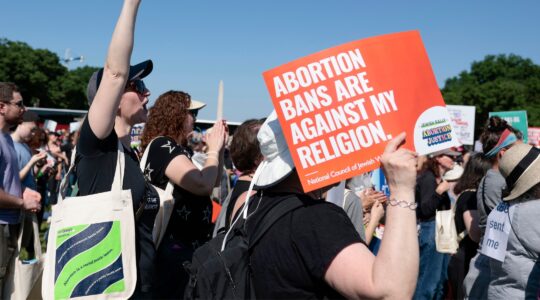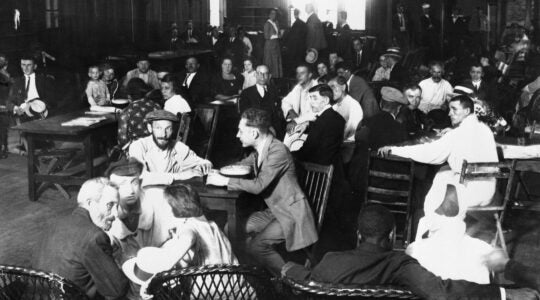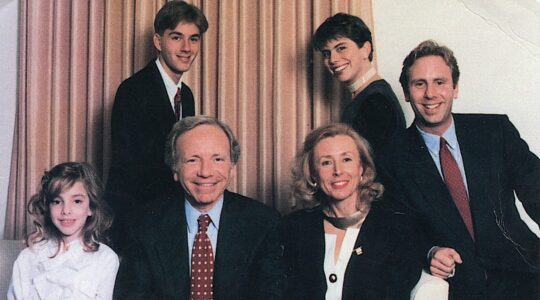NEW YORK (JTA) — We’re at it again, defining the lines of who’s in and who’s out as the debate on Jewish continuity in America rages on. Steven M. Cohen’s latest sociological study on intermarriage, titled “The Tale of Two Jewries,” argues that intermarriage is the single greatest threat to Jewish continuity. His report should raise concerns in its underlying premise and reliance on contested findings in the 2000-2001 National Jewish Population Survey. Using these findings frames the debate as one where Jewish communities are shrinking. Rather, we’re growing. The Steinhardt Social Research Institute at Brandeis University recently confirmed claims that the NJPS numbers were too low. Rather than 5.2 million, the Steinhardt institute found that there are 6 million to 6.4 million American Jews, and potentially as many as 7.5 million if we include Americans who have Jewish family backgrounds but are not Jewish “by religion.” The institute found that undercounting was highest among Jews in their 20s and 30s and the non-Orthodox due to how the NJPS was conducted.Ironically, the institute’s findings recognized what Cohen’s research on Jewish culture and engagement confirm — that there is a larger, more diverse Jewish body out there, and we’d be stronger and smarter to embrace that diversity.Undercounting in the NJPS also reflects Cohen’s findings that younger Jews express their identity in new ways outside of synagogues, JCCs and the federation system — outside of how institutions often gather statistics.This younger culture “on the outside” also reflects the growing economic divide in America. Today, many of us in our 20s and 30s are barely making ends meet. Most likely we will be the first generation who will not do as well, let alone supersede, the economic gains of our parents. With tuition hikes, paycheck paralysis, high housing costs, student loan debts, an unchecked credit industry and lack of adequate health coverage, many of us live paycheck to paycheck. So even if educational initiatives are a way to go, and we can debate what “meaningful education” means, Jewish leaders will have to confront the fact that nearly all Jewish educational programs cost money. From Hebrew school to adult education programs, to synagogue membership and High Holidays services, individuals and families are facing stark economic obstacles.We need our institutional leaders to tackle these bread-and-butter divides.We are also living in times when marriage itself is on the decline. A recent U.S. Census Bureau survey found that married-couple households in the United States are now outnumbered. A hair more than half — 50.3 percent — of households are headed by unmarried people, and 31.7 percent of American children are being raised in unmarried homes. Whether Jewish foundations like it or not, the face of what a family looks like has changed and will continue to change. Variance in Jewish life is not new. We have a long history of movements forming under varying social conditions, giving rise to something new — from the Haskalah during the Enlightenment, to Bundism, to the rise of Conservative Judaism. These shifts are part of the growth and diversity of Jewish life. Ultimately, people want to do what is right, and their underlying intention is a good one — to sustain Jewish life.The problem is the implementation and the overall message that Cohen’s latest report on “Two Jewries” spells out — that some are worthy and others are not.These findings fly directly in the face of values we claim to hold dear — values of diversity and openness, of a just democracy. Unfortunately this leads us on a dangerous path in which some institutions speak of what they want to see Jewish families and individuals look like rather than embracing us for who we are.As such, many Jews have internalized the message that they are not wanted and doors are shut. What then of the Jew who has a non-Jewish mother or father, is a single parent, not circumcised, is black, adopted, low-income or LGBT? In this latest round, I’m ready to throw in the towel and say enough. The language of who is worth engaging should raise serious warning flags, for as Jews we all have known what it means to be on the outside.When this game of divide, divide, divide ends, who will be on the other side? Jews are so much more than who we marry, our religious affiliation or who birthed us. We have seen this for some time. Who chooses to see may depend on where you sit on the dividing line. We need our institutions to be bolder in embracing the diversity that makes up Jewish U.S. life; we don’t need them to split us further apart.When you’re ready, we’ll be here. More of us than you know.(Cole Krawitz is a freelance writer and editor of JVoices.com. Cole recently worked at Demos, a national public policy organization dedicated to building a just democracy and ending economic inequality.)
Divisiveness divides Jews
Advertisement
The views and opinions expressed in this article are those of the author and do not necessarily reflect the views of JTA or its parent company, 70 Faces Media.





